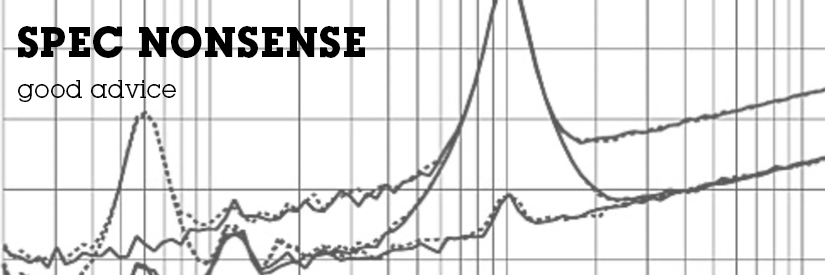Spec Nonsense
- Posted on

Very few people who have been involved in hi-fi for any length of time have failed to encounter the notion that components that measure alike sound alike. For instance, the idea that turntables with the same wow, flutter and rumble specifications can be expected to sound the same is almost universally prevalent. In the case of loudspeakers, anechoic frequency response is commonly taken as an important parameter of performance. Also, it is accepted by a few hi-fi reviewers that amplifiers with similar distortion measurements can be expected to sound pretty much the same. In each of those examples, nothing could be farther from the truth.
It is extremely difficult, for example, to find two amplifiers by different manufacturers that sound even vaguely similar, irrespective of what the numbers say. This is true of any type of component. As a matter of fact, if you audition several samples of the very same model of any component, you are unlikely to find any two which sound exactly alike. The human auditory system is so incredibly sensitive, and the human brain is so powerful in its ability to process information, that the unavoidable minute differences between mechanical or electrical parts will produce consistently audible differences between different specimens of the same component. The truth is, specifications are essentially useless in comparing the performance of different products
This probably sounds like an extreme statement, but we think it is justified. While those of you who have been involved in hi-fi for some time will probably realize that specifications are limited in their ability to predict performance, there remains, nonetheless, the idea that they at least provide rough guidelines or starting points in selecting equipment. This is not the case. If we examine the simple example of amplifier power ratings it will provide some insight. We will take an extreme situation, where one amplifier is rated at 20 watts/channel at a given distortion and one rated at 200 watts/channel at the same distortion. (You may know that it is impossible to state amplifier power in several ways, and produce greatly disparate figures. At one time, RMS, IHF, and Peak power were all commonly used specifications. However, in this instance, we will be comparing power figures derived in the same way, using the continuous power of the amplifier into an eight ohm load.) Under these circumstances almost everyone would expect, given the two figures, that the amplifier with the 200 watt rating will have more power. This does not always turn out to be true.
In the first place, you have to be clear on what you're talking about. For purposes of using an audio amplifier, "more powerful" means "will drive the speaker louder". So, when you say an amplifier is more powerful, you mean that it will provide more volume before it clips or distorts. Consequently, the amount of power the amplifier will produce on a load resistor really makes no difference to you whatsoever. Most of us do not drive load resistors in our living rooms (and have very little interest in doing so). Nonetheless, this is how amplifiers are virtually always measured. Their power and distortion figures are derived while driving an 8 or 4 ohm resistor, which is meant to simulate a speaker of similar impedance. Unfortunately, it doesn't work that way.
